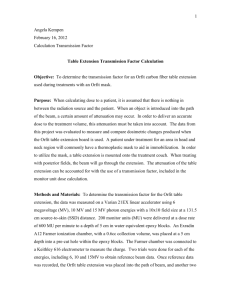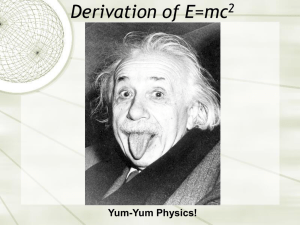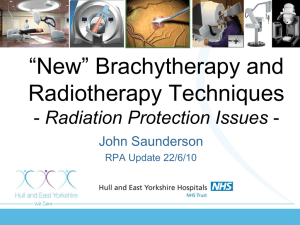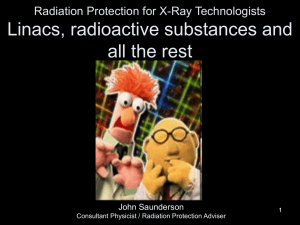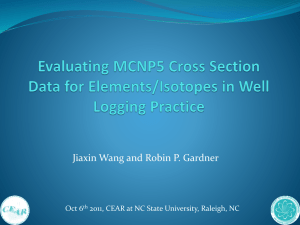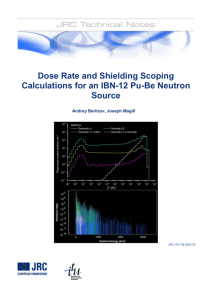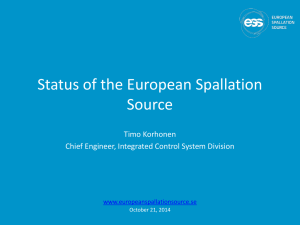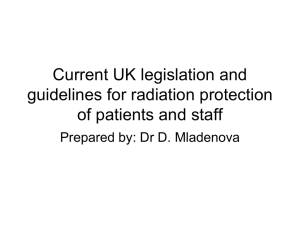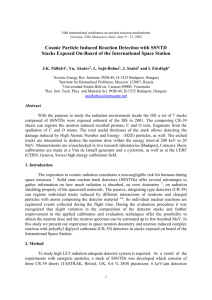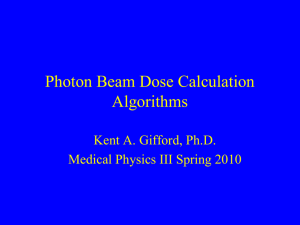Shielding Measurements For A Proton Therapy Facility
advertisement
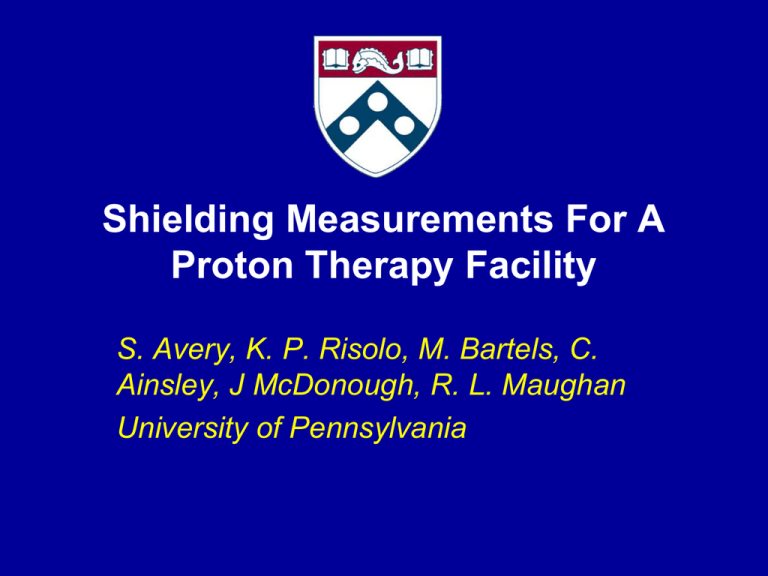
Shielding Measurements For A Proton Therapy Facility S. Avery, K. P. Risolo, M. Bartels, C. Ainsley, J McDonough, R. L. Maughan University of Pennsylvania Introduction I/II • Penn’s Roberts Proton Therapy Center – 5 Treatment rooms – Single Scattering, Double Scattering, Uniform Scanning, Modulated Scanning • Double scatting beam line components – First and second scatters – Modulator wheel – Primary jaws – Collimator (MLCs) – Compensator Introduction II/II • Shielding calculations performed using analytical methods including neutron spectra • Calculations performed for IBA double scattering mode – Max beam current – At any particular energy – Usage factors – Beam direction – Occupancy factors – Workload Methods and Material I/V Methods and Materials II/V Methods and Materials III/V • Both photon sensitive and neutron sensitive detectors required – Total instantaneous dose equivalent obtained from their sum • Neutron detection – Prescila detector for up to 100MeV • Photon detection – Ludum ion chamber Methods and Materials IV/V • Integrated dose equivalent readings – Neutrak Dosimeters inside a Luxel plastic blister pack • Two types of detectors used: –Those sensitive to 40 keV to 40 MeV with a dose range of 0.2 mSv to 250 mSv –Those sensitive to fast, intermediate, and thermal neutrons with a dose range of 0.1 mSv to 250 mSv Methods and Materials V/V • Detectors placed at various locations around facility – Primarily around treatment rooms 1 and 5 – Fast neutron detectors left in for one month – Fast, intermediate, and thermal neutrons left in place for an additional month – Control detectors for each type Results I/V • A modified form of NCRP Report No. 51 equation used to calculate instantaneous dose equivalent index rate • Φp derived from Monte Carlo using GEANT4 • Np is proton beam intensity at the neutron source, related to beam current • Measurements normalized to a beam current of 6 nA emerging from the nozzle Results II/V • Points outside the cyclotron and ESS showed shielding to be more than adequate with only one reading above background – Reading 4-5 times below the calculated value • Points outside TR1 showed 2 readings below background, with 6 other readings found below their calculated values • Measurements with the dose badges showed only photon irrdatiation Results III/V • Neutron dose equivalent transmission data from NCRP Report 144 used with the analytic method • Measurements made under identical gantry angle and proton energy conditions for both neutron and gamma ray dose • The instantaneous and integrated two month dose equivalent data allows for calculate of annual dose equivalents Results IV/V γ-ray DE rate Gantry Ludlum Ion Location Angle Chamber Neutron DE Total γ + neutron rate DE Rate Ludlum Prescila Meas. Calc. 1 270 0.23 1.98 2.22 16.14 9 90 0.7 12.72 13.42 68.7 16 270 0.23 1.05 1.28 12.35 21 270 1.63 9.22 10.86 16.06 27 180 0 1.05 1.05 9.2 Results V/V Contributions to DE Dose Equivalent (µSv) RadiatContributing Patients ion Location Source Treated Quality Deep 5 Room 5 615 Photon 50 20 Room 5 615 Photon 150 Eye 50 150 Shallow 30 120 25R 26A 26B 26C 60 130 70 10 100 140 50 20 20 20 34 Room 5 Room 1 Room 1 Room 5 Cyclotron Vault 615 453 453 615 Photon Photon Photon Photon 50 130 70 10 2316 Photon 20 Conclusions • Shielding in place at Roberts Proton Center is more than adequate – Conservative shielding calculations • Measured vs. Analytic • Film dosimeters questionable – Only saw photon component Concluding Remarks • Thanks to the authors Dr. Avery, Dr. Maughan, Dr. McDonough, Dr. Ainsley, and Mr. Bartels • Thanks to the HPS
